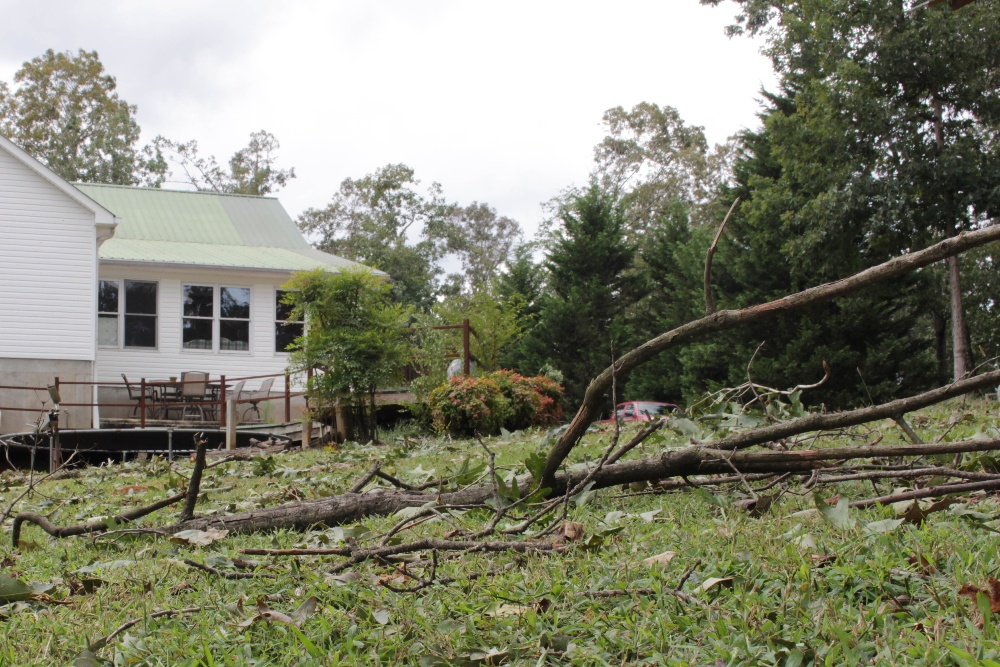

When a hurricane or tropical storms sends tree limbs crashing to the ground and floodwaters over your lawn, there are steps you can take to minimize storm damage.
Before we outline those steps here, we want to take a moment to recognize that hurricane and tropical storm damage reaches far beyond debris-filled lawns. When there are such storms, our thoughts and prayers are with those who suffer the consequences after natural disasters.
For those surfacing to evaluate outdoor damage and commence post-storm yard cleanup, we have advice gathered from the Davey blog and their recommendations on How to Clean up the Yard and Trees after a Storm, with special emphasis on handling tree problems. However, we’ve added in our own key lawn tips for you to keep in mind during this season.
Follow along with these step-by-step tips to care for your lawn after the storm.
1. Plan to treat Bipolaris with 5-10-30 fertilizer
Bipolaris is a lawn disease that results from a lack of potassium, and it attacks warm season lawns like Zoysia, Bermuda, and Centipede. Bipolaris is caused by 10 hours per day of moisture on leaves but worsens when the ground dries out. Also, high nitrogen applications augment the disease, so go easy with that nutrient.
If you’ve already had a problem with bipolaris, the heavy rain from a hurricane or tropical storm can create the “perfect storm” for Bipolaris because the rain has likely leached out potassium you have recently applied to address the problem. If you haven’t had the problem yet, please look out for it because the dry forecasts projected in the next couple of weeks may cause the disease to manifest.
Because hurricane and tropical storms are the perfect conditions for helping bipolaris thrive, Super-Sod stores stock high-potassium, low-nitrogen 5-10-30 fertilize to treat the Bipolaris problem.
2. Inspect trees and power lines before clean-up
Before heading outside, make sure there are no downed power lines or trees leaning on power lines. Safety first! Before roaming around your yard to clean up, inspect trees that look as if they may pose a safety risk. Call a tree professional if this is the case.

3. Separate trash into piles
According to one Florida report, the best way to stay organized during clean-up is by separating the various debris in your yard into three piles: vegetation, garbage, and construction waste. Vegetation should include larger limbs and branches that you can easily move.
Keep the piles clear of power lines, fire hydrants, and mailboxes so trash trucks can access them without having to maneuver around the stationary obstacles.
4. Rake up twigs, leaves, and debris
Moisture from leaves left on your lawn will contribute to the likelihood of damage from Bipolaris.
You can add tree debris to your vegetation trash pile or repurpose them. Repurpose them by adding the leaves to a compost pile or setting aside twigs to use as kindling.

5. Evaluate plant damage
If tree stems or trunks have completely snapped, they are not likely to recover and you will, unfortunately, need to remove them.
Many annuals, perennials, and vegetables will recover if you give them plenty of water and are patient as they regrow. Simply trim off damaged leaves and let your plants continue to grow.
6. Plan to fix drainage issues
After the big storm’s deluge, it’s likely you’ll notice areas of your lawn that hold water longer than others. Even in a typical rain storm, these areas usually take a while to drain. During yard clean-up, take note of these problem areas so you can fix them in the future.
To fix areas with standing water, level uneven parts of your lawn with Level Mix, a combination of 70% sand and 30% compost that will provide structure and promote growth in your lawn. Learn How to Topdress and Level a Lawn.
If it makes sense to add some extra landscaping to the area with drainage problems, explore options such as installing a dry creek or even planting water-loving bushes such as chokeberry, buttonbush, and Virginia sweetspire.
Keep these tips in mind as you clean up your lawn after hurricanes and tropical storms.

If you’re seasoned at post-storm lawn cleanup and have any other tips, we would love to hear them. Comment below to tell us about how you care for your lawn after storms.




